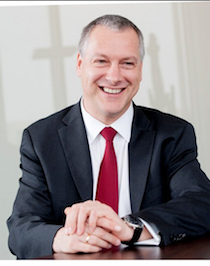IoT reaches new heights with cloud technology in elevators

Andreas Schierenbeck, thyssenKrupp Elevator
Andreas Schierenbeck, the chief executive of thyssenKrupp Elevator, discusses how modern IoT developments are bringing one of the world’s oldest industries – construction – into the 21st century.
The fact our world has gone digital is no secret. Every day, increasingly sophisticated technologies and online platforms are being developed; each opening up a whole host of new opportunities to improve not just the world we live in, but also the way we live in it.
The IoT is playing an ever-important role in this new digital landscape, offering us ways to make our world smarter and more interconnected than it has ever been before. However, as such a broad-reaching and somewhat abstract concept, it is crucial for industry and business leaders globally to truly understand the IoT and data behind it. Doing so will not only ensure its proper application as a tool for change, but will also help deliver tangible business benefits in their operations.
Some industries are already using the IoT to great effect. The aviation sector, for example, has incorporated cloud-based machine learning into its everyday practices and operations, which has successfully increased both safety and reliability. In the buildings too, IoT-based systems are catalysing changes in a number of ways, such as better regulation of air conditioning services to offer enhanced comfort to building users as well as improved energy efficiency credentials.
For the elevator industry, the IoT might not be an obvious connection. However, if used effectively, it can drastically improve how buildings work and how they can be designed to run more efficiently. This is particularly important considering the increased pressure rapid population growth and urbanisation is putting on our cities the world over. In fact, 80% of the world’s population is expected to live in cities by the end of the century, so our urban landscapes require robust, future-proof innovations to ensure buildings can withstand this pressure and deliver a sustainable built environment for years to come.
Part of the challenge is meeting the needs of our increasingly tall buildings. We are truly the skyscraper generation, with the world’s current tallest building, the Burj Khalifa, standing more than 63% taller than Taiwan’s Taipei 101 tower, which held the world’s tallest title just 10 years ago. These lofty heights – coupled with an ageing population – have made elevators an integral and crucial part of our building and city life. There are more than 12 million elevators worldwide, with more than 1 billion journeys being taken every day. Realising the potential that the IoT has to help our elevators meet the needs of our growing – and heightening – cities is the key to ensuring optimum mobility and building efficiency, and providing long-term sustainable cities of the future.
In the elevator market, downtime – meaning when an elevator is either not running properly, or broken – is a real problem, impacting on building efficiency and the productivity of the people relying on these elevators to move them about the building. In economic terms, unproductivity is hugely damaging; just 49 minutes of wasted office time costs the UK economy around £26 billion every year. At thyssenkrupp Elevator, this challenge was a natural target for us to apply IoT technology and make a difference.
Working with Microsoft, we created a brand new IoT platform, called MAX, which connects elevators and components across the world to the cloud. Here, their lifecycle data is analysed so that MAX can predict when the elevators are going to fail, before it happens. Able to reduce elevator downtime by 50%, MAX has the potential to significantly enhance our buildings’ efficiency levels – which in turn improves the efficiency of the wider cities in which these buildings are located. On a more people-focused level, this development also minimises the stress experienced by building users unable to reach their destination; a sign of how IoT innovations can have a positive impact on not just operational objectives but consumer ones too.
MAX certainly provides a great solution for thyssenkrupp’s part of the construction sector, but considering the potential for this innovation in combination with IoT-driven systems being put in place across the wider built environment, allows us to see the mighty power that the IoT has to bring cities across the globe into the 21st century.
Digital innovations will of course become ever-more sophisticated over time, but, finding ways to take the ideology of the Cloud and apply this in a practical way to our businesses and environment, sets our cities up with a great foundation level of future-ready technology that can evolve and grow in synergy with digital developments that are yet to come.
With technology advancing and changing our lives by the day, it’s hard to imagine exactly what the world will look like in 20, 50, or 100 years’ time, but my firm belief is that the IoT will be at the very heart of it.
